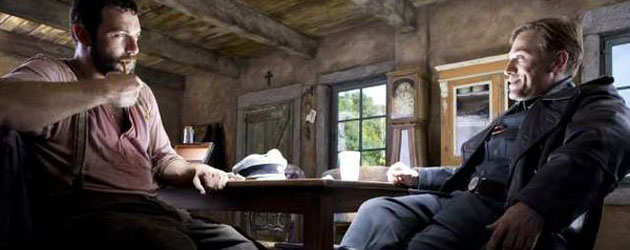David Wasco & Sandy Reynolds-Wasco

DW: We had no notice when we started on Inglourious Basterds. We had the script sent to us on a Friday and we were on a plane on Monday to go to Berlin. We were ten weeks from shooting when we were flying to Berlin, which is an unusually short prep-time for a period film. The ultimate deadline was one year from day one of principal photography- Quentin really wanted the film at the Cannes Film Festival. We were the ones who got crunched with having no prep, not knowing anything about the movie. Even though we have a rapport with Quentin we would rarely get a script early on, where we could think about it. It comes to us ten weeks before we’re going to shoot! I don’t think he quite understands what we do and how it could be better if we had a bit more time to be able to think about things!
But because we had this rapport with Quentin and knew how he worked, that gave us a leg up on actually being able to pull it off. At first it was like, Can we even pull this off? because it was quite a Herculean ambition.
What had happened was an opportunity allowed us to get the best team in Germany. Polanski was just starting to gear up and shoot The Ghost Writer at Babelsberg Studios and he had Germany’s A team working with him but something happened and the money fell through and they pulled the plug on the project. It freed up this group of people and I was able to get Sebastian Krawinkel and his team of Art Directors and Set Designers. It also freed up all the stages. We had sets in every single stage in Babelsberg. The studio was actually built in the twenties for Fritz Lang. Joseph Goebbels had an office there when it was a propaganda studio.
SRW: But it was a film production studio way before that regime.
DW: Yes, Fritz Lang’s Metropolis was shot there. The Blue Angel was shot there. Recently, Speed Racer. Quentin chose to go there because he wanted to be on the same turf as Fritz Lang. He wanted to be standing on the same floor that these actors had performed on.
I ended up getting this really great team and they spoke perfect English. Had I not had this great team it would have been difficult. I was only able to bring Sandy. I did lobby to bring an art director -I wanted to bring an art director that I used on Royal Tenenbaums, Carl Sprague, who spoke German and had worked in Berlin. But they only let me take Sandy so all of Sandy’s department, the set decoration department, and the art department, the prop department, everyone was local. It was an incredibly talented crew.
SRW: It helped having a crew that was like a machine within itself. They’d all worked together. This was really lucky because had there been ten weeks of prep with the normal number of expected glitches, we would have been fine, but there were three big challenges thrown in the mix before shooting. One thing was that it was originally going to be shot black and white right up until the scene where the Nazi’s redress the theater and the premiere begins.
Thank you for publishing such a great, in-depth interview with The Wasco’s! – it really captures how wonderful and talented they are, and their love and respect for cinema and architecture. And I really enjoy your blog in general – what a cool resource of ongoing conversations! Keep it up!
Robert Foulkes/Location Manager
I agree with Robert. I’ve read every single one of your interviews and everyone offers such great advice. Inglorious Bastards was such a great film and to hear their story makes it even better. I’m on the distribution and sales side of the business, but my passion has always been designing and art, so to read these stories is truly inspiring.
Thank you!!!